chef’s table
EVOKING ITALIA
Chef Tim Magee imports Tuscan cuisine to Reno.
WRITTEN BY SANDRA MACIAS
PHOTOS BY SHEA EVANS
Homemade ravioli prepared by Calafuria’s owner-chef Tim Magee
Tim Magee, a third-generation Nevadan, returned not too long ago to his hometown after spending 15 years in Italy — Tuscany, to be exact — studying its cuisine. The tasty fruition of all those years is Calafuria, the Reno restaurant Magee opened in March 2016, seven months after returning home.
Calafuria’s home, a little house on South Center Street, once was Rose’s, a busy sandwich place. After Rose’s, two other eateries opened and closed in quick order. But Magee, the Irish-Italian chef, and his Roman wife, Cristina De Nigris, are here to stay — they’ve bought the place with Reno partners Frank Magee (Tim’s brother) and Ben Kennedy.
Magee views his young restaurant as a “work in progress.” He describes his hours in the first few months of opening as “screwball.” First, lunch only, then prix fixe dinners Thursday through Saturday. And, finally, it became simply a dinner house offering an à la carte menu or a tasting menu for the table.
Calafuria is a social, happy, lively place with an energetic, open kitchen dominating a corner space. And it’s non-fussy: wood floors, slatted-wood window shades, simple wood-top tables with bench seats for parties of six or more, and fun topiary photos on white walls. Inside seating accommodates 45; outside can handle 40.
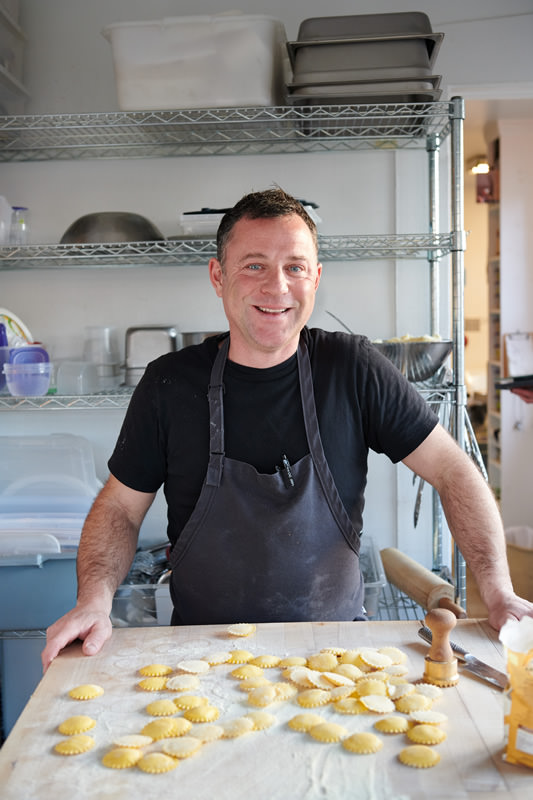
Owner-chef Tim Magee makes Calafuria’s ravioli by hand
Imported inspiration
The restaurant is named after a beach area near Livorno, a port city on Tuscany’s west coast. Magee lived in Pisa, working in restaurants there and on Livorno’s sea coast. A man who wears many hats, he also worked in an artisan gelato shop and spent a year as an apprentice at Cioccolato De Bondt, a world-famous artisan-chocolate shop.
One of the first lessons of his restaurant training was cooking fish, a staple of this sea coast area.
“They treat fish like meat, seasoning it with sage and rosemary. It was like nothing I’d ever seen,” he says.
And it also seemed an interesting culinary stew, he adds.
“This area has a crazy mix of cultures, from African to Spanish, Jewish, and Italian. I imported the cuisine to Reno, as much as possible, and did not Americanize it — except for the Caesar salad,” Magee says, flashing a smile.
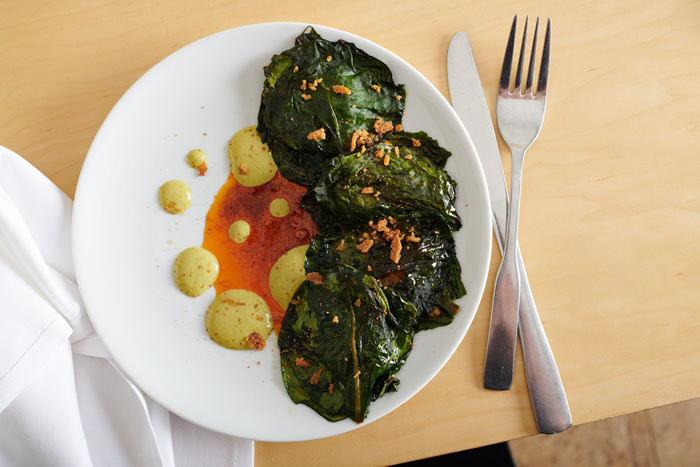
Grilled duck wing, pickled-apple-and-pumpkin chutney, pickled rapini mustard sauce, beet greens, paprika oil, fried bread, and pickled onion dust
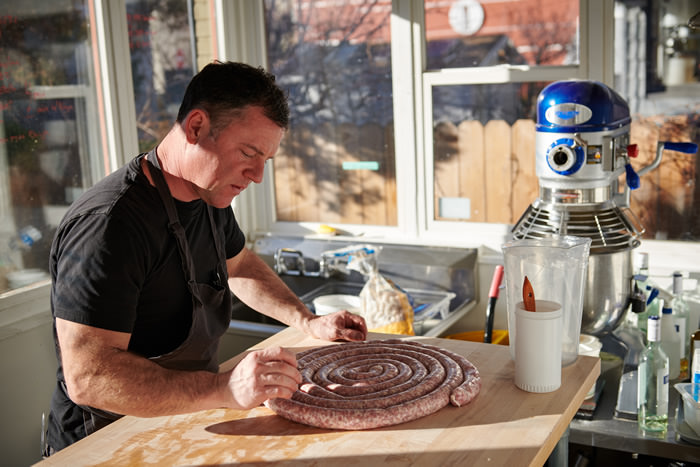
Calafuria’s owner-chef Tim Magee makes Tuscan pork sausage
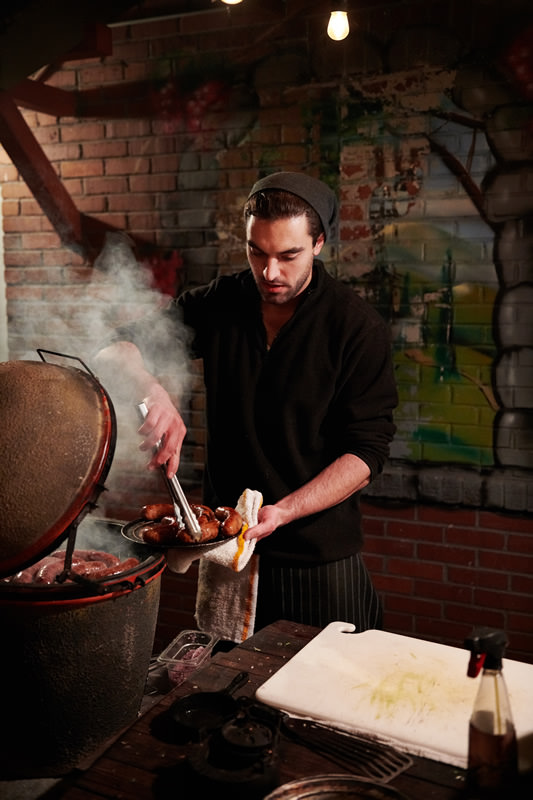
Line cook Chadd Carter prepares Tuscan pork chorizo, made with chile powder, and pork sausage on the wood-fired grill on Calafuria’s patio
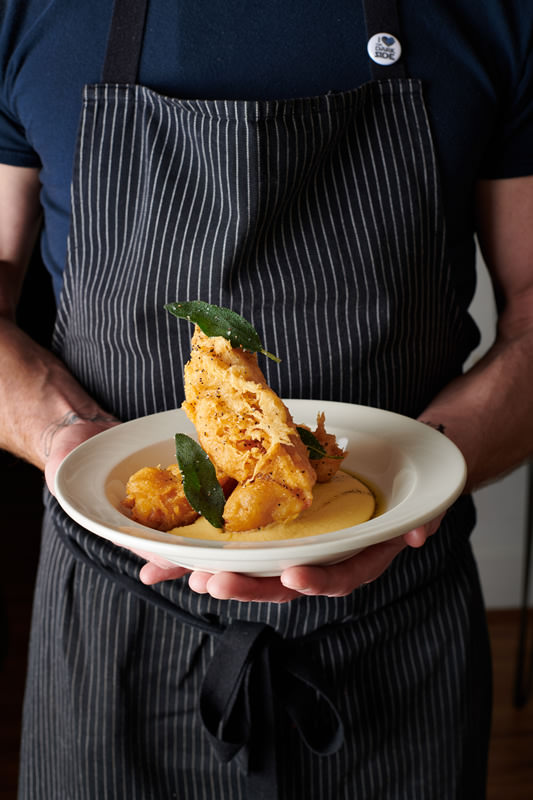
Calafuria’s fried baccalà features tempura-battered, fried salted cod served with a ceci bean purée and topped with sage and a drizzle of rosemary oil
Domestic flavors
Calafuria’s kitchen staff proudly cooks from scratch using fresh, local ingredients. The restaurant’s sauces, dressings, soups, pastas (except rigatoni), and breads (of absolutely perfect texture and crust) are made in house. So are charcuterie meats (except prosciutto), marmalades, syrups, vinegars, and limoncello.
Local suppliers include the Great Basin Community Food Co-op and Ponderosa Meat & Provision Co., both in Reno.
“Not all the meat is local,” Magee says, “but they are high in quality.”
Sierra Gold Seafood, a Reno distributor, supplies fresh fish, octopus, and even red mullet, a rarity in this area.
The menu features typical Tuscan dishes using ingredients such as ceci beans (garbanzos), baccalà (dried, salted cod), and assertive herbs. Examples include fried calamari with sage, capers, and lemon aioli; fried baccalà with ceci bean purée and rosemary olive oil; and chicken ravioli with sage and prosciutto sauce. Springtime specials include shrimp-and-scallop ceviche and pasta with salmon and fresh dill.
Other Tuscan choices include grilled sausage with sautéed peppers — Tuscan to the core. The house-made sausage is cooked on a wood-fired grill and gets rave reviews, as does the cioppino, a seafood stew chock full of octopus, mussels, scallops, and baccalà in a luscious tomato sauce. The dish is a riff on cacciucco, the famed stew of Livorno.
Such food needs bold wines. Magee’s wife is chief adviser for Calafuria’s wine list, which offers distinctive Italian and French wines. She became an oenophile when the couple opened Ristorante Le Nuvole in 2008 in Suvereto, a medieval village in the Tuscan hills surrounded by a noble wine-producing area. An Italian food critic described her wine list at Le Nuvole as “precise and clear.”
“I was exposed to so many good wines,” De Nigris says. “It opened the world to me.”
De Nigris’ aim is to offer “a dynamic wine list”: wines made by small vintners, wines of top quality but priced fairly, and “wines that our customers drink and remember.”
She recommends two Tuscan blends to try with your meal: Bolgheri Rosso and Insoglio del Cinghiale.
Calafuria continues to be a work in progress. Plans include an extended patio in the backyard and a garden. Another project involves the brick two-story building buttressing the back alley — in its day a carriage house. The ground floor is being renovated to make way soon for a wine bar.
“What I’m doing here is bringing home all the experiences I had with so many chefs and people,” Magee says. “Me, getting back here, was a long, long road.”
And his efforts are the soul of Calafuria.
Sandra Macias, a Reno food writer, enjoyed interviewing Tim Magee and his wife, Cristina De Nigris, and would like to share a few leftover items that didn’t make it in the article: 1) In 2013, Magee spent four months in Copenhagen, Denmark, working (with 40 other chefs) at Noma, a Michelin two-star restaurant since 2008 that was named the No. 1 Restaurant in the World in 2010, 2011, 2012, and 2014 by Restaurant Magazine. He says it was “like just starting over. It was difficult, but amazing.” 2) For fun, Google “ristorante le nuvole suvereto,” then scan down to the video/vimeo and watch Magee, who didn’t know the language when he arrived in Italy, in an interview speaking fluidly in Italian. “He even picked up an Italian accent,” his wife confides.
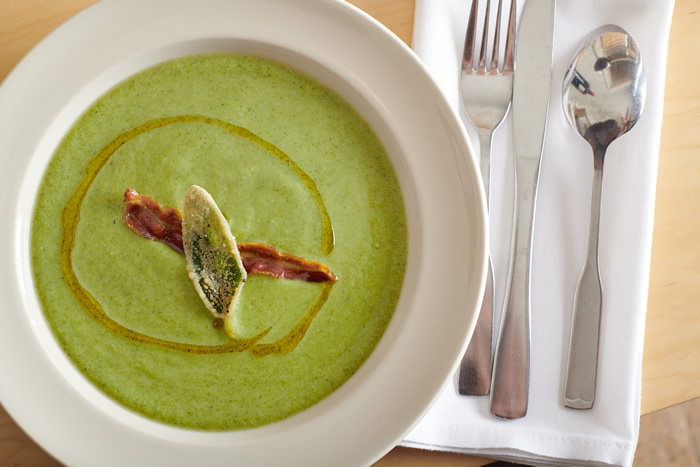
Broccoli soup topped with crispy fried pancetta and fried sage
Resouces
Calafuria
725 S. Center St., Reno • 775-360-5175 • Calafuria.com
Open 4:30 p.m. – 9 p.m. Tues. – Sat. (aperitivo at 4:30 p.m.; dinner at 5:30 p.m.).
Reservations appreciated (highly recommended, if you don’t want to be disappointed).
Recipe
Broccoli Soup
(courtesy of Tim Magee, owner-chef, Calafuria in Reno. Serves 4)
“Tuscany is known for a rich vegetable soup called ribollita, which has all sorts of vegetables, beans, and old, crusty bread,” Magee says. “Unfortunately, you can’t taste any one vegetable. I was struck with the freshness and incredible flavors of the vegetables I was buying in Tuscany, so I came up with this technique, which allowed me to showcase one vegetable using very few ingredients.”
2 heads broccoli
3½ ounces (about ⅓ to ½ cup) good extra-virgin olive oil
Salt, to taste
Garnishes (see instructions below):
Rosemary-flavored olive oil
Crispy pancetta
Fried sage leaves
Cut off crowns from broccoli heads. Peel stems and cut in half. Boil crowns and stems in salted water until very tender. Drain and reserve some of the water, about ⅓ to ½ cup.
In blender, purée broccoli with reserved water. As it blends, add olive oil. It will emulsify and become lighter in color.
Warm up soup, then serve it with a drizzle of rosemary oil on top, a sprinkle of crispy pancetta, and fried sage.
To make rosemary oil
Stir 1 tablespoon dried rosemary with about 1 cup olive oil. Allow time to let rosemary infuse oil.
To fry pancetta
Mince 1 to 2 ounces pancetta (some supermarkets sell it minced and packaged). In nonstick pan with a little oil, cook over medium-high heat until crisp.
To fry fresh sage leaves
Dust a moist sage leaf in flour and cook in nonstick pan with a little oil. It will crisp up quickly. Dry on paper towel.


